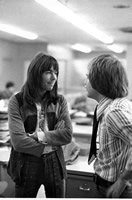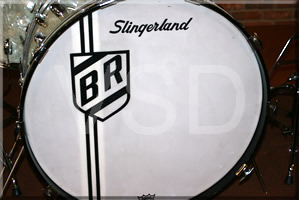Maybe it’s silly, but think about it, what
are the odds? We were not suppose to move from inner Chicago but
did. We could have moved anywhere, but landed in Norwood right between
Donny and Slingerland. Donny and I didn't have to hit it off. Donny
could have kept them. The drums were slated to be destroyed back
at the factory. God, fate, destiny, karma and definitely the Osborne's
saw to it I got them.
The first rock drummer that came through that I
met was Nigel Olsson for Elton John. Slingerland was making a push
to get into the rock market and they some how heard that Elton was
about to pop here in the United States. Slingerland had always focused
on jazz players and now that Mc Millan Publishing wanted to be aggressive,
it was getting to be a pretty interesting to work. In the later
part of August of 1970, Elton and the band were on their way to
the Troubadour in LA to make their U.S. debut. Slingerland had been
in touch with the management and Nigel stopped by the factory on
his way to Los Angeles.
 Nigel and Rick
Nigel and Rick |
The set that we made for Nigel at that time was
one of the most massive sets out. It was a double bass drum set,
with three toms mounted on each. Nigel was concerned about reaching
two of the toms as they were mounted as a cluster. I ran to the
machine shop and bent the single tom holder arm and it worked
out great. Although they took the set to L.A., they may have used
the Premier set since Nigel and the sound people were probably
more comfortable with it.
Nigel is one of the nicest people in the industry.
He innovates allot of things in his playing and is rock solid
as Elton demands that. Some listeners may blow off these little
things and patterns Nigel plays in the background to shade and
ad texture because they want to hear massive bombastic stuff like
a Keith Moon, but if you take these unique ideas out of the recording,
it just is not the same. Nigel is a tasty, innovative player.
He is fun to work with, knows what he wants and has a positive
attitude. He works with you and is an innovator when it came to
drum set design too. It was Nigel's idea to make sets with extended
sizes and the long bass drums.
At that time, we all made the traditional sizes.
Then we got into the variable concert tom,” open bottom
head” concept arrangement that Carl Palmer and Hal Blaine
used. Drum nuts know Louie Bellson had long bass drums when he
was with Gretch many years before but Nigel drew from the idea
and asked us to two special sets for him in which consisted of
10x6, 10x 8, 10x10, 12x12,13x13, 14x14, 16x16 and 16x18 with a
20x20 bass drum. One set had wooden hoops and the other metal.
The wooden hoop set was for recording and had 4 tone controls
2 on top and 2 on the bottom. The snare drums were about 7-1/2
x 14 or 8 x 14. All the drums were maple with the 5 ply shells.
After Nigel hit the road with the deep toms, everybody started
making them. It was time for a change.
That set came about because there was a misunderstanding
between Nigel and the company and it was Slingerlands fault totally.
When I learned of it issue, I had a snare drum made up in a new
denim finish we were promoting and then took it down to the old
Chicago Stadium. Uninvited, I talked my way (along with the Osborne’s)
back stage in an attempt to save our relationship with Nigel.
As always Nigel was gracious, open, and touched that we came down
to talk with him.
We
did this because we liked the guy and what Elton was doing musically.
We felt bad about it and if nothing more I wanted to clear things
up.
|


